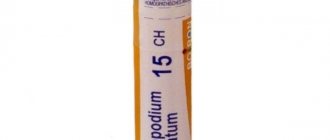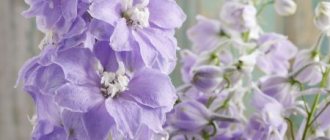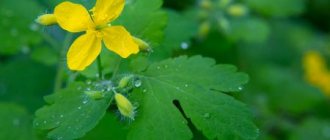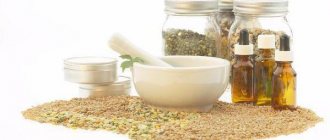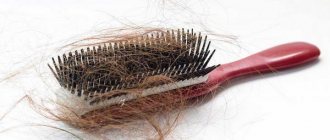Monkshood (Aconitum napellus) is a turnip-shaped fighter.
This is a perennial plant from the ranunculaceae family. It is also popularly known as “root fighter”, “wolf fighter”, “dog potion”.
The properties of this plant were known already in ancient times, its name is covered in legends. According to one of them, aconite grew from the poisonous saliva of the terrified hellish dog Cerberus, whom Hercules led from the underground dark kingdom to the earth flooded with the rays of the sun.
The fighter is poisonous. It contains aconitine, which affects the central nervous system and causes convulsions and paralysis of the respiratory center.
In folk medicine, aconite is used for neuralgia, migraine, and rheumatism.
Physiological action
Leaving aside poisoning with aconite, which paralyzes the nervous system and leads to death so quickly that symptoms useful to us for therapeutic purposes do not have time to develop, we will study only the results of the action of aconite tincture on a healthy person, paying special attention to disorders of the circulatory system, which is the most important .
The tincture of aconite in moderate doses, depending on the sensitivity of the subject undergoing the test, produces at first an increase in cardiac activity, causing a full, firm and rapid pulse, a significant increase in temperature and blood pressure.
This is the basic action of aconite, which the homeopath should never forget, and which gives him the key to the main therapeutic indicators.
A sharp stimulation of blood circulation causes the following symptoms: tinnitus, dizziness, headaches. The soft palate, uvula, tonsils, cheeks, ears, as well as the connective membrane of the eyes are hyperemic. Capillaries rupture from tension, resulting in bruising, ecchymoses, hematomas and nosebleeds. The whole face turns red due to a rush of blood to the head, there is a tickling in the larynx with a feeling of roughness. The eyelids and eyeballs are hyperemic, lacrimation increases. The laryngoscope shows hyperemia of the entire mucous membrane of the larynx, which can spread to the trachea. Then there is a secretion of visible mucous membranes, accompanied by chills, followed by dilation of the capillaries of the skin, and finally the secretion of sweat.
Depending on the dose, aconite produces two types of fever: one, which we have just described, with symptoms of inflammation in the form of: redness of the face, rapid and full pulse, increased temperature, and the other: with a pale, emaciated face, cooling of the body and weakness of the pulse.
High doses of aconite act on the nervous system of warm-blooded animals as follows: first - direct, easy stimulation of the bulbar brain centers, then - a reflex action due to irritation of the nerve endings of various excretory organs (lungs, bronchial mucosa); this reflex action causes excitation of the vagus and splanchnic nerves, which is ultimately followed by paralysis.
Aconite causes a disorder of pain sensitivity, mainly in the region of the trigeminal nerve. Aconite also acts on motor nerves, but not in the same way as curare - muscle contraction stops along with the motor function of the nerve. Before paralysis sets in, aconite produces a spasm, and lockjaw is a common symptom of aconite poisoning. The following symptoms are the result of the action of aconite on the nervous system: various pains, but mainly tugging and shooting in the region of the branches of the trigeminal nerve, in the muscles of the chest, throughout the body; increased sexual feelings; hyperesthesia of the olfactory nerves, pressure in the pit of the stomach, dizziness with fainting when standing up and moving to a vertical position. Feeling of numbness and goosebumps in the lips and nose, painful tingling in the tip of the tongue; a feeling of tightening of the skin of the face and squeezing in the limbs, as if they were tightly tied with a rubber bandage. At the same time, the subject becomes very sensitive to wind and experiences a purely subjective sensation of cold. Memory and thinking become sharper. Restless sleep, nightmares, extremely unstable mood, deep melancholy.
Breathing becomes irregular in number and rhythm, which leads to symptoms of suffocation. These disorders are the result of spasm of the muscles of the chest and diaphragm.
Aconite also has an effect on the digestive system. Among the main symptoms we note: severe thirst, nausea and vomiting, a feeling of painful heaviness in the stomach, colic and bloating. Aconite causes diarrhea rather than constipation; it is preceded by colic and rumbling. The stool is greenish or whitish, as with jaundice. Poisoning with aconite sometimes presents a picture of cholera disease.
Aconite increases all kinds of discharge: the amount of urine increases and sweat becomes profuse. Aconite has a predominant effect on some organs and tissues: the larynx, heart, sclera, pleura, peritoneum and joints.
It is extremely important to note that all symptoms caused by aconite may disappear within a few hours and the body begins to function normally again. The stronger the dose and the more intense its effect, the faster the depression follows the symptoms of excitement. Hahnemann well noticed and interpreted this phenomenon. In his “Medicinal Science” we read: “Exacerbation of memory” is immediately followed by the opposite symptom: “weakness of memory”, and regarding this contradiction he adds: most of the symptoms of aconite, which seem to exclude each other, are only alternatives (phenomena depression follows excitement), and aconite may be useful in either one or the other of these symptoms. During autopsies, the following are observed: rushes of blood to the lungs and brain; inflammation of the gastrointestinal tract, serous effusions into the pleura, arachnoid membrane and peritoneum; nodular mitral valve lesions have been observed in animals exposed to prolonged exposure to aconite.
Instructions for use, dosage for adults and children
Most often, aconite is taken in the form of homeopathic granules. This is done 30 minutes before meals or an hour after meals.
The number of granules depends on the disease. For example, if a person has the flu or acute respiratory viral infection with a high fever, he can consume 5 - 8 granules up to 5 times a day. Doctors also prescribe aconite for children, but in a different dosage.
- In this case, the child is given 1–3 granules.
- After two days, the intake is reduced to 3 times a day. In general, the granules are taken in a course lasting 2 weeks.
When treating chronic diseases, aconite is used for 4 weeks, first as described above, and for weeks 3–4 – 8 granules 2 times a day.
Aconite tincture can only be drunk by adults.
The intake scheme is called a “slide”. On the first day, dilute 1 drop of tincture in 0.5 glasses of water, on the second day – 2 drops. Next, increase the amount of product used to 10 drops. Then the countdown begins: 9 drops per day, then 8, 7 and so on.
When the course is completed, experienced herbalists advise brewing and drinking agrimony for 2 weeks - it will cleanse the liver of toxic substances contained in aconite.
Characteristic
1. Extreme anxiety and agitation with excessive melancholy and fear of death. This condition occurs in severe cases of inflammatory fevers, in certain heart diseases and in exophthalmic goiter.
This fear, as well as the illness that causes agitation in the patient, are characteristic of this remedy.
2. Fear of crossing the street, going into society, fear that something might happen, fear is constant, incomprehensible, inexplicable. Here we note that aconite is an excellent remedy for diseases that have developed as a result of fright, recent and distant (opium, ignatia, veratrum album).
3. Diseases and pains that appear after exposure to cold wind. Other chief remedies relating to dry and cold wind; bryonia, causticum, hepar sulfur and nux vomica.
4. The severity of symptoms that appear suddenly and immediately develop with great severity.
5. Worsening of symptoms: agitation, pain, melancholy, etc. at night, especially after midnight.
The pain of aconite is unbearable, sharp, tearing, accompanied by extreme excitement, melancholy, fear: the patient rushes in different directions, being unable to bear this pain or withstand touch.
The pain worsens at night, around midnight, as are the symptoms of this remedy in general.
They are replaced by a feeling of numbness, tingling, goosebumps.
And the etiology is most important: exposure to dry, cold air. Stools are frequent, scanty, with tenesmus and unbearable urge.
Diarrhea, with gastric mucous or chopped spinach-like stool in children during the hot season. Relief occurs after sudden release of mucus or blood.
Menstruation: very heavy, long, sometimes short-lived, or replaced by nosebleeds in strong and full-blooded women.
Sudden stopping due to fear, anger, strong excitement, even joy, or exposure to a dry, cold wind.
Tincture of aconite and more
Various types of preparations are made based on the plant. For each of them, extracts of varying concentrations are used.
- Infusions. Made from dried herbs and flowers, brewed with boiling water.
- Oils. Take sunflower or olive oil as a basis and add dry plant powder.
- Ointment. Made from petroleum jelly, fresh or dried parts of the plant are added.
- Tincture. Produced on the basis of alcohol, it is stored for a long time.
When purchasing, you should pay attention to the concentration of active substances and read the instructions for use. The drugs can be easily counterfeited by using any other similar plant as a basis. Therefore, you need to buy from trusted sellers. Pharmacies sell mainly ointments, rarely tinctures.
In our online store you will find only natural gifts of nature. We know how to properly harvest and store herbs, and we can easily distinguish a quality product. Real forest medicines in one place:
- Convenient delivery and secure payment.
- Compliance with storage conditions and monitoring expiration dates.
- Nice prices and satisfied customers all over the country.
Order aconite tincture to have on hand in your home medicine cabinet.
Main indications
Aconite is the best remedy for inflammation, flushing and arterial hyperemia; this is an excellent anti-inflammatory, but it corresponds only to the beginning of inflammation (formation period), losing its indications as soon as the rush of blood is localized, transudate, hepatization or tissue changes appear.
It is necessary to know for sure that aconite corresponds mainly to diseases due to exposure to dry, cold wind, due to fear, cessation of sweating; those cases that are characterized by the severity of symptoms, violent, sudden, acute onset with fever - that is why it is, first of all, an important remedy for inflammation and congestion of the lungs, especially in plethoric, sanguine and strong subjects.
ACTIVE IDIOPATHIC CONGESTIA (forms of Voile, Potena, Granchet) with full, hard, galloping pulse and increased blood pressure. On the contrary, aconite is absolutely contraindicated in cases of passive adynamic hot flashes with a decrease in blood pressure, such as typhus. And with hot flashes, due to asystole with a threadlike pulse with a decrease in blood pressure, it is even harmful. The site of selective action of aconite is the upper lobe of the left lung. If the tide could not be stopped by aconite, and if inflammation of the tissue has developed, then it loses its strength and bryonia can take its place in pleuropneumonia, and phosphorus in splenopneumonia.
FOR BRONCHITIS, PLEURITIS, (as well as inflammation of the pelvic peritoneum), aconite is used initially; the indication for it is determined by the nature of the fever, and in case of damage to the respiratory tract, by cooling as the cause of the disease.
Runny nose: there is not only painful dryness in the nose, but also dryness and a feeling of heat in the skin, and a flow of blood from the periphery to the center.
LARINGO-TRACHEITIS of aconite is often a consequence of cooling without perspiration (that is why belladonna is more suitable for children who often catch colds when running around in perspiration). Aconite cold - a cold when walking in an open carriage, with chills; while staying in cold rooms. Here are the readings of aconite. An excellent regulator of blood circulation, aconite is also indicated for hemoptysis.
Nosebleeds with increased blood pressure.
HEMOPTYSIS with anxiety and fear. Aconite corresponds to congestive hemoptysis at the beginning of tuberculosis, caused by a sudden cold: an alarm signal that should not be neglected.
SONGINS with fever, burning, purple throat, excitement and melancholy; We must not forget about the etiology - the common cold.
RHEUMATISM. Aconite is the main remedy against acute articular rheumatism. For acute local manifestations of rheumatic diathesis, during a febrile period, aconite is often a very effective remedy: for lumbago (bryonia, rus, actea, puxivomica), scleritis (spigelia), pleurodynia (ranunculus bulbosus), sciatica and other neuralgia of a rheumatic nature.
COLD FACIAL NEURALGIA affects mainly people prone to hot flashes and congested. Aconite is especially indicated when there is severe congestion in the affected part, usually the face, which in such cases becomes red and swollen. A crawling sensation in the affected part; the pain drives the patient almost to despair. This pain is extremely sharp at the beginning and is always accompanied by a crawling sensation and numbness.
HEART DISEASES. Aconite is an excellent remedy for aortitis and in the initial stages of endocarditis. Palpitation with a feeling of melancholy. Attacks of sharp pain spreading from the heart to the left hand and accompanied by a feeling of numbness and crawling in the fingers.
INCREASED BLOOD PRESSURE without organic damage. Nothing compares to aconite for its rapid action in cases of acute high blood pressure. Aconite eliminates such increases without damage irrevocably, while in patients with arteriosclerosis it only decreases for several days, weeks, etc. months, because painfully altered arteries in these cases fatally lead to increased pressure again.
Equally, aconite appears to be effective AT THE BEGINNING OF ENDOCARDITIS, PERICARDITIS AND ARTERITIS with increased pressure. It also retains all the power of its action in acute or subacute cases of hot flashes during chronic diseases.
Smokers under the influence of nicotine may experience a spasm of the vessels supplying the large arterial trunks (aorta). As a result of malnutrition of the vascular walls, a general circulatory disorder in the form of palpitations, arrhythmia and even angina attacks can be observed. In all such cases, the administration of aconite often gives brilliant results.
IN CARDIAC OVERSTRESS IN ATHLETES, when an increase in blood pressure is followed by asystole and a dangerous decrease in blood pressure, giving all phases of aconite poisoning.
ARNICA acts more slowly in the same cases.
SEVERE JAUNDICE. The pathogenesis of aconite gives symptoms of severe jaundice (icteric discoloration of the skin, hemorrhages, fever). But phosphorus reproduces these symptoms even better, so aconite and phosphorus are two remedies against severe jaundice; here aconite is used in low dilutions.
HEADACHE. Congestive headache, with a feeling of fullness, as if a weight were pressing on the head in the forehead. Headache with a feeling of heat, heaviness, throbbing, splitting, after a cold or exposure to the sun. Sensation of flushing with intense heat, accompanied by violent palpitation of the heart, pulsation of the arteries, in the temples, with fever, melancholy, fear.
COUGH - usually dry and short whistling, as with croup, worse in the evening, at night from dry cold wind or draft, smoking, drinking. Nothing seems to make it easier. It is accompanied by shortness of breath, acute pain, fever, agitation and melancholy. It appears suddenly in full-blooded children who have caught a cold during the day; during the first sleep between 9 and 11 pm, before midnight; cough is hoarse, strong, almost immediately suffocating; the child grabs his throat with his hands and suffocates; he is excited, sad and afraid.
Aconite cough either without sputum at all, or with a small amount of viscous mucus.
Auscultation does not give anything here, because... aconite corresponds only to the simple stage of irritation, which is immediately followed by the stage of true tide.
FEVER. In general, aconite is useful at the onset of any acute, not too severe fever, following a cold, characterized by redness of the face, which turns pale on rising from bed, thirst with the need for large quantities of water, and especially severe dryness of the skin, the functions of which seem to have ceased due to spasm of the capillaries . In these same cases, aconite, due to its stimulating effect on the circulatory system, causes a rush of blood to the surface of the skin and, consequently, the appearance of relieving sweat. As soon as the patient sweats, the indications for aconite end. Urinary retention in children at the beginning of inflammation clearly indicates aconite.
Thus, aconite is a remedy against sthenic or simple inflammatory fever. An insignificant effect is obtained only with septic fevers and accompanying local inflammation.
Aconite: description and properties
A beautiful flower - poisonous and healing. There are many legends associated with it; its bright purple blooms are mesmerizing and attract attention. The leaves are dark green and always shiny.
The main part of the toxic substances is concentrated in the rhizome. The plant grows up to a meter and blooms from late June to July.
There are several species that differ in the shape of the leaves, sizes and shades of flowers: yellow, purple, blue, white.
Aconite is used with caution in landscape design. Pollen from some species can cause irritation, so children and animals are at risk.
In natural conditions it is most often found in Asia and Russia. More than 20 species grow in Siberia, more than 30 in the Far East.
In the CIS countries the flower is called differently: buttercup, blue-eyed, fighter. The main active ingredient is alkaloids. In moderate concentrations, the compound has a powerful healing effect, but in large quantities it causes poisoning.
Another substance is aconitine. The content is significantly less, so with moderate use it has no effect.
